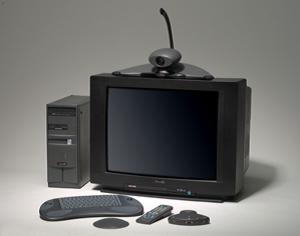There are technologies that capture our imagination, hopes and desires—but then fail to deliver in the end. It’s what I call “white elephant” technologies; dazzling at first glance, but what do you do with it day to day? In past years it was the lore of videoconferencing technology, then smart boards, and now, lecture capture. Although some productively use these tools, for the majority of users, they have been a disappointment.
My experience with videoconferencing is representative. I was involved with a large videoconferencing project to connect cultural, educational and business organizations in the borough of the Bronx. Funded by a Bell Atlantic grant, we used ISDN lines and Polycom 360 desktop and room units. From the start, there were technical issues with the lines and the equipment never worked reliably, if at all. The images were grainy and frequently either the audio or video would drop in the middle of a conference. The phone company and vendor were always pointing fingers at each other, but mostly the telecommunication lines were not properly configured for videoconferencing. In the end, the entire project failed, and the staff, myself included, was laid off.
That experience caused some skepticism when I subsequently worked at a CUNY community college and users were promised videoconferencing between campuses. The first demonstration of the system was a total disaster, and I knew the system would never be reliable, easy-to-use, or be beneficial at all. Even the greatest advocate of the technology would soon give up in frustration. Predictably, after several years, the project was abandoned and largely forgotten.
What can be learned from these “white elephants”? I have a few ideas regarding new technologies for teaching and learning:
- Make sure there is an actual need.
- Make sure it actually works.
- Make sure it is user-friendly.
- Make sure there is sufficient support.
- Make sure it won’t soon become obsolete.
- Make sure it’s cost-effective (and other less costly solutions don’t exist).
- Make sure that the users are part of the decision-making process.
These suggestions seem obvious to those of us involved with technology implementation over the many, many years. The fact that I have seen these wonders come and go, gives me a more critical perspective than one who sees the pluses without the downsides. Although I have been critical of faculty resistance to new technology, on this score, I’m not. Over the years, faculty have been burned by promises of technology purporting to improve classroom teaching, only to have reality provide a sobering antidote to any initial enthusiasm. For example, for every smart board (used generically) put up in a K-12 classroom that is being fully utilized, there are at least ten languishing in classrooms around the country. Either faculty have not been adequately trained on these devices, find their use too difficult to be bothered with, don’t feel the benefits are worth the hassle, or don’t get the support they need when a problem arises. The end result is a waste of resources, and another “white elephant” gets relegated to an educational cage.
Sometimes the issue is not necessarily that the technology itself that serves a real pedagogical purpose and even is relatively simple to use. Lecture capture may be a good example. The rationale is that students can view a professor’s lecture at their leisure, as many times as is required to master the material. From the professor’s vantage point, some of these systems are as simple as pressing a button to start recording, and pressing another one to finish. The file is labeled, uploaded to a server, and links provided for students. What can be simpler?
The problem as I see it, is that no real analysis was done initially to see the larger picture. What is the context of this technology for teaching and learning?
- Does this technology promote good pedagogy?
- Are there other means (even less costly ones) to achieve the same ends?
- How are students using this technology?
- Can students record lectures themselves?
The more you dig into the specifics of lecture capture, the more issues arise that work against its value. For example, isn’t lecturing an example of an older style of pedagogy that often turns students off and reinforces a passive approach to learning? Does this technology merely reinforce in electronic form a style of teaching that is in bad need of revamping? An early criticism of online courses was that they were mere “electronic page turners.” Well, isn’t this mere “electronic lecture recording?”
Not to pick on lecture capture, but there are other technologies like webinars that allow for two-way dialoguing with students, cost less to set up, and may be used remotely when the professor cannot attend class. If the lecture capture setup is fixed in a classroom, what happens if the teacher can’t make it to class? With webinars, the show may go on.
What is needed to avoid such situations? Although there are no guarantees, I feel that a representative committee of technologists, faculty and administrators need to carefully consider, research, test, and plan for various instructional technologies on their campuses. Such decisions should not be the sole domain of an administrator or even the Director of Instructional Technology. Stakeholders need to weigh in and have their reservations heard and considered. Although this process can be messy and time consuming, it may result in “white elephants” becoming as rare as “black swans.”
Image Credits:
White Elephant (from Wikipedia: http://upload.wikimedia.org/wikipedia/commons/9/9d/RoyalWhiteElephant.jpg)
Videoconferencing System (from website: http://www.medwow.com/video-conferencing-equipment.xth191_200_160.jpg)
Black Swan (from Wikipedia: http://en.wikipedia.org/wiki/Black_swan_theory)






Pingback: Footenotes » Blog Archive » Round-Up!